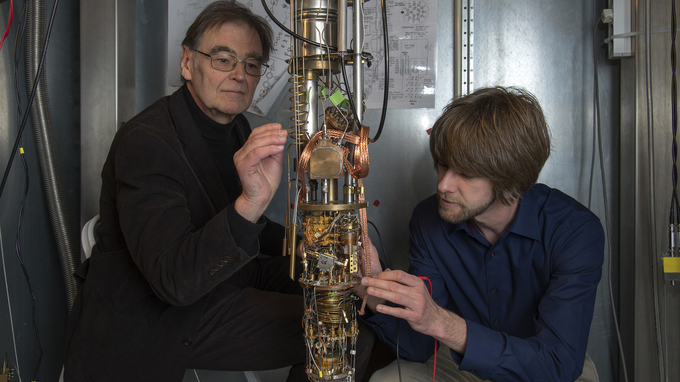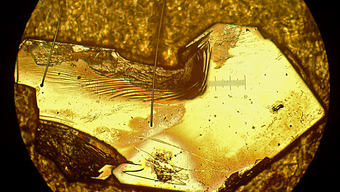Supraleitung im Land der „schweren Elektronen“
Wechselspiel von elektronischem Magnetismus, Kernspins und Supraleitung
2016-02-01 – Nachrichten aus dem Physik-Department

Supraleiter transportieren Strom völlig ohne Widerstand und sind daher technisch von höchstem Interesse. Während es für die klassische Supraleitung eine physikalische Erklärung gibt, ist bisher nicht klar, wie sie in Hochtemperatur-Supraleitern zustande kommt. Weltweit suchen daher Forscher nach Modellen und Mustern, die dieses Phänomen erklären können und sie dem Fernziel, der Supraleitung bei Raumtemperatur, näher bringen.
Forscher eines internationalen Teams um Erwin Schuberth, Professor an der TU München und am Walther-Meißner-Institut der Bayerischen Akademie der Wissenschaften, Professor Frank Steglich, Direktor am Max-Planck-Institut für Chemische Physik Fester Stoffe in Dresden sowie Qimiao Si, Professor an der Rice University in Houston (USA) und Professor Rong Yu von der Renmin University in Peking haben nun einen Mechanismus entdeckt, der in einer Verbindung aus Ytterbium, Rhodium und Silizium bei sehr niedrigen Temperaturen Supraleitung entstehen lässt.
Im Land der „schweren Elektronen“
Im Gegensatz zu Neutronen und Protonen, den Kernbausteinen, sind Elektronen extrem leicht. Sie gehören zur Teilchenklasse der Fermionen. In speziellen Legierungen und unter bestimmten Bedingungen verhalten sie sich jedoch, als wären sie Tausend mal schwerer. Die von den Wissenschaftlern untersuchte Verbindung aus Ytterbium, Rhodium und Silizium (YbRh:sub:2Si2) ist ein typischer Vertreter dieser „Heavy Fermion“-Systeme genannten Materialien.
„Es gibt bereits überzeugende Beweise, dass die nichtklassische Supraleitung sowohl in kupferbasierten als auch in eisenbasierten Hochtemperatur-Supraleitern in enger Verbindung mit Quantenfluktuationen steht. Diese verändern die magnetische Ordnung der Materialien an ‚quantenkritischen Punkten’, Schwellenwerten am Übergang von einer Quantenphase in eine andere”, sagt Qimiao Si. „Diese Arbeit liefert den ersten Beweis, dass ähnliche Prozesse in „Heavy Fermion“-Systemen Supraleitung bewirken.”

Ultra-tiefe Temperaturen
In der Arbeitsgruppe von Frank Steglich werden „Heavy-Fermion“-Systeme wie das Ytterbium-Rhodium-Silicid schon seit mehr als 15 Jahren intensiv untersucht. In früheren Untersuchungen wurden Quantenfluktuationen durch ein äußeres Magnetfeld erreicht, das jedoch einen Übergang zur Supraleitung verhinderte.
Für ihre neuen Versuche nutzten die Wissenschaftler einen Kernentmagnetisierungs-Kryostaten des Walther-Meißner-Instituts in Garching. Dieses Gerät kann Proben bis zu einer Temperatur von 400 Millionstel Kelvin hinab kühlen. Bei einer Übergangstemperatur von zwei Millikelvin wurden die Proben plötzlich supraleitend.
Bei Messungen der spezifischen Wärme erkannten die Autoren überrascht, dass die effektive Masse der Ladungsträger ihrer Legierung um einen weiteren Faktor 1000 anzusteigen schien, wenn man das Material zu Temperaturen unterhalb des supraleitenden Übergangs kühlte. „Das zeigt klar, dass im Bereich ultra-tiefer Temperaturen Wechselwirkungen mit den Kernspins der umgebenden Atomkerne am Werk sind “, sagt Erwin Schuberth. „Sie bilden eine magnetische Ordnung aus, die Supraleitung möglich macht.“
Kernspins arrangieren sich neu
Die Messergebnisse wurden von den Theoretikern Qimiao Si und Rong Yu analysiert. Sie fanden, dass ein spezielles Arrangement der Kernspins des Ytterbiums die Voraussetzung für die Supraleitung ist. Nach ihrer Theorie koppeln die Kernspins bei extrem tiefen Temperaturen untereinander und ordnen sich in einer Art und Weise, die mit der antiferromagnetischen elektronischen Ordnung konkurriert und diese entscheidend abschwächt. Auf diese Weise kommen die elektronischen „quantenkritischen“ Fluktuationen zum Tragen, die treibenden Kräfte für die Supraleitung.
„Die Arbeit zeigt, dass das Entstehen nichtklassischer Supraleitung in der Nähe antiferromagnetischer Instabilitäten ein allgemeines Phänomen ist“, sagt Frank Steglich. „Es ist nicht beschränkt auf die Kuprate und organischen Supraleiter sondern tritt auch in den Heavy-Fermion-Materialien auf, Modellsubstanzen für Quantenmaterie mit extrem starken elektronischen Korrelationen.“
Die Forschungsarbeiten wurden unterstützt von der Deutschen Forschungsgemeinschaft (DFG), der Robert A. Welch Foundation und der National Science Foundation (NSF).
- Redaktion
- Dr. Andreas Battenberg, Dr. Johannes Wiedersich
Veröffentlichung
Kontakt
- Prof. Dr. Erwin Schuberth
- Walther-Meißner-Institut, Bayerische Akademie der Wissenschaften undLehrstuhl für Technische Physik, Physik-Department, Technische Universität MünchenWalther-Meißner-Str. 8, 85748 Garching, GermanyTel.: +49 89 289-14203E-Mail: eschuber@ph.tum.de